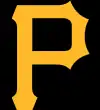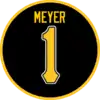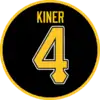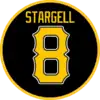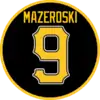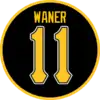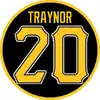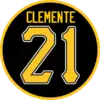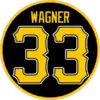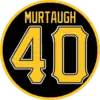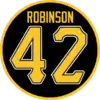Pittsburgh Pirates
The Pittsburgh Pirates are an American professional baseball team based in Pittsburgh, Pennsylvania. The Pirates compete in Major League Baseball (MLB) as a member club of the National League (NL) Central division. Founded as part of the American Association in 1881 under the name Pittsburgh Allegheny, the club joined the National League in 1887 and was a member of the National League East from 1969 through 1993. The Pirates have won five World Series championships, nine National League pennants, nine National League East division titles and made three appearances in the Wild Card Game.
| Pittsburgh Pirates | |||||
|---|---|---|---|---|---|
| Established in 1882 | |||||
| |||||
| Major league affiliations | |||||
| |||||
| Current uniform | |||||
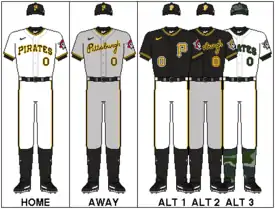 | |||||
| Retired numbers | |||||
| Colors | |||||
| Name | |||||
| |||||
| Other nicknames | |||||
| |||||
| Ballpark | |||||
| |||||
| Major league titles | |||||
| World Series titles (5) | |||||
| NL Pennants (9) | |||||
| Central Division titles (0) | None | ||||
| East Division titles (9) | |||||
| Wild card berths (3) | |||||
| Front office | |||||
| Principal owner(s) | Robert Nutting | ||||
| President | Travis Williams | ||||
| General manager | Ben Cherington | ||||
| Manager | Derek Shelton | ||||
Despite struggling in the 1880s and 1890s, the Pirates were among the best teams in baseball shortly after the turn of the century. They won three NL titles from 1901 to 1903, played in the inaugural World Series in 1903 and won their first World Series in 1909 behind Honus Wagner. The Pirates took part in arguably the most famous World Series ending, winning the 1960 World Series against the New York Yankees on a walk-off home run by Bill Mazeroski, the only time that Game 7 of the World Series has ever ended with a home run. They also won the 1971 World Series, led by the talent of Roberto Clemente, and the 1979 World Series under the slogan "We Are Family", led by "Pops" Willie Stargell. After a run of regular-season success in the early 1990s, the Pirates struggled mightily over the following decades with 20 consecutive losing seasons from 1993 to 2012—the longest such streak in American professional sports history.[4] The Pirates returned to the postseason in 2013 and advanced to the NLDS. The team qualified for the postseason again in 2014 and 2015. The Pirates currently have the longest World Series appearance drought in Major League Baseball amongst any team with at least one appearance and the longest pennant drought in the National League,[5] their most recent showing being their victory in the 1979 World Series. From 1882 to 2020, the Pirates have an overall record of 10,564–10,446 ( .503 winning 'percentage')[6]
The Pirates are also often referred to as the "Bucs" or the "Buccos" (derived from buccaneer, a synonym for pirate). The team plays its home games at PNC Park in Pittsburgh's North Side, its home since 2001. The Pirates previously played at Forbes Field from 1909 to 1970 and at Three Rivers Stadium from 1970 to 2000. Since 1948 the Pirates' colors have been black, gold and white, matching the other professional sports teams in Pittsburgh, the Steelers and the Penguins.
Franchise history
Professional baseball in the Pittsburgh area began in 1876 with the organization of the Allegheny Base Ball Club, an independent (non-league) club based in a then-separate city called Allegheny City, across the Allegheny River from Pittsburgh. The team joined the minor league International Association in 1877, only to fold the following season.[7] On October 15, 1881, Denny McKnight held a meeting at Pittsburgh's St. Clair Hotel to organize a new Allegheny club,[8] which began play in 1882 as a founding member of the American Association. Chartered as the Allegheny Base Ball Club of Pittsburgh,[9] the team was listed as "Allegheny" in the standings, and was sometimes called the "Alleghenys" (rarely the "Alleghenies") in that era's custom of referring to a team by its pluralized city or club name. After five mediocre seasons in the A.A., Pittsburgh became the first A.A. team to switch to the older National League in 1887. At the time, William A. Nimick was club president and Horace Phillips manager.[10]
Before the 1890 season, almost all of the Alleghenys' best players bolted to the Players' League's Pittsburgh Burghers. The Players' League collapsed after the season, and the players were allowed to go back to their old clubs. However, the Alleghenys also scooped up highly regarded second baseman Lou Bierbauer, who had previously played with the AA's Philadelphia Athletics. Although the Athletics had failed to include Bierbauer on their reserve list, they loudly protested the Alleghenys' move. In an official complaint, an AA official claimed the Alleghenys' signing of Bierbauer was "piratical".[11] This incident (discussed at some length in The Beer and Whisky League, by David Nemec, written in 1994) quickly accelerated into a schism between the leagues that contributed to the demise of the A.A. Although the Alleghenys were never found guilty of wrongdoing, they made sport of being denounced for being "piratical" by renaming themselves "the Pirates" for the 1891 season.[12] The nickname was first acknowledged on the team's uniforms in 1912.
After almost two decades of mediocre baseball, the Pirates' fortunes began to change at the turn of the century. The Pirates acquired several star players from the Louisville Colonels, who were slated for elimination when the N.L. contracted from 12 to 8 teams. (The franchises did not formally consolidate; the player acquisitions were separate transactions.)[13] Among those players was Honus Wagner, who would become one of the first players inducted to the Baseball Hall of Fame. The Pirates were among the best teams in baseball in the early 1900s, winning three consecutive National League pennants from 1901 to 1903 and participating in the first modern World Series ever played, which they lost to Boston. The Pirates returned to the World Series in 1909, defeating the Detroit Tigers for their first ever world title. That year, the Pirates moved from Exposition Park to one of the first steel and concrete ballparks, Forbes Field.
As Wagner aged, the Pirates began to slip down the National League standings in the 1910s, culminating in a disastrous 51–103 record in 1917; however, veteran outfielder Max Carey and young players Pie Traynor and Kiki Cuyler, along with a remarkably deep pitching staff, brought the Pirates back to relevance in the 1920s. The Pirates won their second title in 1925, becoming the first team to come back from a 3-1 deficit in the World Series.[14] The Pirates returned to the World Series in 1927 but were swept by the Murderer's Row Yankees. The Pirates remained a competitive team through the 1930s but failed to win the pennant, coming closest in 1938 when they were passed by the Chicago Cubs in the final week of the season.
Despite the prowess of Ralph Kiner as a slugger, the Pirates were mostly miserable in the 1940s and 1950s. Branch Rickey was brought in to rebuild the team, which returned to the World Series in 1960. They were outscored over the course of the series by the Yankees, yet the Pirates won on a walk-off home run by Bill Mazeroski in the bottom of the 9th inning in Game 7. As of 2020, it is the only Game 7 walk-off home run in World Series history.
Led by right fielder Roberto Clemente, the Pirates remained a strong team throughout the 1960s but did not return to the World Series until 1971. Playing in the new Three Rivers Stadium, the Pirates defeated the favored Baltimore Orioles behind Clemente's hitting and the pitching of Steve Blass. In the same year, the Pirates became the first team to field an all-Black and Latino lineup.[15]
Despite Clemente's death after the 1972 season, the Pirates were one of the dominant teams of the decade, winning the newly-created National League East in 1970, 1971, 1972, 1974, 1975, and 1979. Powered by sluggers such as Willie Stargell, Dave Parker, and Al Oliver, the team was nicknamed "The Lumber Company." Behind Stargell's leadership and disco song "We Are Family", the Pirates came back from a 3-1 deficit to once again defeat the Orioles in the 1979 World Series for the franchise's fifth championship.
The Pirates sank back into mediocrity in the 1980s and returned to post season play in the early 1990s behind young players like Barry Bonds, Bobby Bonilla, and Doug Drabek. The Pirates won three straight division titles from 1990 to 1992 but lost in the National League Championship Series each time, notably coming within one out of advancing to the World Series in 1992. Several of the team's best players, including Bonds and Drabek, left as free agents after that season.
With salaries rising across baseball, the small-market Pirates struggled to keep pace with the sport and they posted a losing record for 20 consecutive seasons, a record among North American professional sports teams. Even the opening of a new stadium in 2001, PNC Park, did little to change the team's fortunes. The Pirates finally returned to the postseason in 2013 behind National League MVP Andrew McCutchen, defeating the Cincinnati Reds in the Wild Card Game. They were eliminated in five games in the next round by the St. Louis Cardinals. That season, the Pirates also became the seventh MLB team to reach 10,000 all-time wins.[16] On Opening Day 2015 the Pirates' loss was the team's 10,000th[17] making the Pirates the fourth MLB team to achieve this distinction, following the Philadelphia Phillies, Atlanta Braves, and the Chicago Cubs.[18] The Pirates returned to the postseason in 2014 and 2015 and lost the Wild Card game both times and have not qualified for the playoffs since then.
Rivalries
Philadelphia Phillies
The rivalry between the Philadelphia Phillies and the Pirates was considered by some to be one of the best rivalries in the National League until 1994.[19][20][21] It began when the Pittsburgh Pirates entered the NL in 1887, four years after the Phillies.[22]
The Phillies and the Pirates remained together after the National League split into two divisions in 1969. During the period of two-division play (1969–1993), the two National League East division rivals won the two highest numbers of division championships, reigning almost exclusively as NL East champions in the 1970s and again in the early 1990s.[21][23][24] The Pirates nine, the Phillies six; together, the two teams' 15 championships accounted for more than half of the 25 NL East championships during that span.[23]
After the Pirates moved to the National League Central in 1994, the teams face each other only in two series each year and the rivalry has diminished.[20][21] However, many fans, especially older ones, retain their dislike for the other team, with regional differences between Eastern and Western Pennsylvania still fueling the rivalry.[25]
Within the Central Division
The Pirates have lacked a consistent rival during their time in the Central Division, as the team has posted a losing record in the majority of its seasons since moving over from the East Division in 1994. Arguably the Pirates' biggest rival is the Cincinnati Reds, given the two teams' proximity, the carryover of the cities' football rivalry, and the fact that the Reds and Pirates have met six times in the postseason,[26] most recently in the 2013 National League Wild Card Game. In the 2010s, the two teams frequently hit each other with pitches, occasionally resulting in brawls.[27]
From 2013 to 2015, the Pirates battled with the St. Louis Cardinals for the Central Division title, with the Cardinals narrowly winning the division each year. The two teams faced off in the 2013 National League Division Series, which the Cardinals won in five games. The Pirates had a contentious[28] battle with the Milwaukee Brewers for a Wild Card spot in 2014 and faced off against the Chicago Cubs in the 2015 National League Wild Card Game. The Cubs were major rivals for the Pirates earlier in their history, as both were among the best teams in baseball in the early 1900s and the Cubs eliminated the Pirates from the pennant race in the last week of the 1938 season.
Interleague
The Pirates play an annual series against the Detroit Tigers. While the Pirates and Tigers only became "natural rivals" because the other AL and NL Central teams were already paired up, it has become popular with fans of both teams, possibly due to the rivalry between the National Hockey League's Detroit Red Wings and Pittsburgh Penguins. The two teams have several other connections as well. The Tigers' AA Minor League affiliate, the Erie SeaWolves, located near Pittsburgh, is a former affiliate of the Pirates and has retained the logo of a wolf wearing a pirate bandanna and eye patch. Additionally, Jim Leyland, former manager of both the Pirates (1986–1996) and the Tigers (2005–2013), remains popular in Pittsburgh where he resides. The Pirates lead the regular season series, 36–29. The two teams played in the 1909 World Series.
An on-and-off rivalry with the Cleveland Indians stems from the close proximity of the two cities, and features some carryover elements from the longstanding rivalry in the National Football League between the Cleveland Browns and Pittsburgh Steelers. Because the Indians' designated interleague rival is the Reds and the Pirates' designated rival is the Tigers, the teams have played periodically, with one three-game series per season from 1997 to 2001, 2003, 2006, 2009 to 2012, 2015, and 2018. Since 2012, the Indians and Pirates play three or four games every three seasons when the AL Central plays the NL Central as part of the interleague play rotation. The Pirates lead the series 21–18. The teams will play six games in 2020 as MLB instituted an abbreviated schedule focusing on regional match-ups, and an additional three games in Pittsburgh in 2021.[29]
Roster
Pittsburgh Pirates 2021 spring training roster | ||||||
|---|---|---|---|---|---|---|
| 40-man roster | Non-roster invitees | Coaches/Other | ||||
|
Pitchers
|
Catchers Infielders
Outfielders
|
Pitchers
Catchers
Infielders
Outfielders |
Manager Coaches
Restricted list 40 active, 0 inactive, 26 non-roster invitees
| |||
Players
Baseball Hall of Fame
| Pittsburgh Pirates Hall of Famers |
|---|
| Affiliation according to the National Baseball Hall of Fame and Museum |
|
Ford C. Frick Award recipients
| Pittsburgh Pirates Ford C. Frick Award recipients | |||||||||
|---|---|---|---|---|---|---|---|---|---|
| Affiliation according to the National Baseball Hall of Fame and Museum | |||||||||
|
Team captains
- Dick Groat -1962
- Bill Mazeroski 1963–1972
- Willie Stargell 1973–1982
- Bill Madlock 1983
Retired numbers
Along with the league-wide retired number of 42, there are nine retired Pirates jersey numbers to date. As of June 12, 2019, Bill Mazeroski is the lone survivor of the Pittsburgh Pirates whose numbers are retired.
|
- This was Wagner's uniform number only during his tenure as coach. Wagner played before there were uniform numbers.
- Robinson's number is retired throughout all Major League Baseball
Franchise records
Win-loss records
- 100 Wins in a Season
- 1902 (103–36), Fred Clarke
- 1909 (110–42), Fred Clarke
- 100 Losses in a Season
- 1890 (23–113), Guy Hecker
- 1917 (51–103), Jim Callahan, Honus Wagner, and Hugo Bezdek
- 1952 (42–112), Billy Meyer
- 1953 (50–104), Fred Haney
- 1954 (53–101), Fred Haney
- 1985 (57–104), Chuck Tanner
- 2001 (62–100), Lloyd McClendon
- 2010 (57–105), John Russell
First-in-MLB accomplishments
- On May 8, 1886, the Pittsburgh Alleghenys turned the first 3–4–2 triple play in Major League history. In the fourth inning of a game, the Cincinnati Red Stockings put runners in first and second with no outs. John Reilly grounded out to first base, where Fred Carroll recorded the first out. He threw to second base, where Sam Barkley made the tag for the second out. The runner for second decided to try for home plate and he was cut down on a throw from Barkley and a tag by Doggie Miller. The Alleghenys won the game, 9–4.
- First ever Major League Baseball game broadcast on the radio, a game between the Pirates and the host Philadelphia Phillies aired August 5, 1921, on KDKA (AM) Pittsburgh. The Pirates won the game, 8–5.
- In 1925, the Pirates became the first MLB team to recover from a 3-games-to-1 deficit in winning a best-of-seven World Series; they then became the first MLB team to repeat that feat in 1979.[30][31]
- During the 1953 season, the Pirates became the first team to permanently adopt batting helmets on both offense and defense. These helmets resembled a primitive fiberglass "miner's cap". This was the mandate of general manager Branch Rickey, who also owned stock in the company producing the helmets. Under Rickey's orders, all Pirate players had to wear the helmets both at bat and in the field. The helmets became a permanent feature for all Pirate hitters, but within a few weeks the team began to abandon their use of helmets in the field, partly because of their awkward and heavy feel. Once the Pirates discarded the helmets on defense, the trend disappeared from the game.[32] In 2014, Major League Baseball allowed pitchers to choose to wear a padded hat that aims to combine the added safety of a helmet with the comfort of a baseball cap.[33] The cap would prove widely unpopular, with only Alex Torres of the New York Mets choosing to wear it.[34]
- First franchise to win a World Series on a home run (1960 World Series) in the 7th game. The only other team to meet this feat is the Toronto Blue Jays in 1993, though they accomplished it in game 6.
- In 1970 the Pirates became the first major league club to create their uniforms using a cotton-nylon blend featuring pull-over shirts and beltless pants.[35]
- The first all-minority lineup in MLB history took the field on September 1, 1971.[36] The lineup was Rennie Stennett, Gene Clines, Roberto Clemente, Willie Stargell, Manny Sanguillén, Dave Cash, Al Oliver, Jackie Hernández, and Dock Ellis.[37]
- The first World Series night game was played in Three Rivers Stadium on October 13, 1971—eleven years to the day since Mazeroski's walk-off homer brought the Pirates their last World Series title in 1960. In this case, however, it was Game 4 between the Pirates and the Baltimore Orioles, rather than a decisive Game 7. Apparently, good things happen for the Pirates on this date, as they knotted the '71 Series at two games apiece on their way to their fourth title.
- The first MLB scout to win the "Scout of the Year Award", Howie Haak, in 1984, three additional scouts from the organization have subsequently won the award.
- The first combined extra inning no-hitter in MLB history took place at Three Rivers Stadium on July 12, 1997. Francisco Córdova (9 innings) and Ricardo Rincón (1 inning) combined to no-hit the Houston Astros, 3–0 in 10 innings. Pinch-hitter Mark Smith's three-run walk-off home run in the bottom of the 10th inning sealed the victory and the no-hitter for the Pirates. It remains the only such no-hitter to date.[38]
- In November 2008, the Pirates became the first MLB team to sign Indian players when they acquired the non-draft free agents of Rinku Singh and Dinesh Patel.[39][40] This was also seen by Pirates general manager Neal Huntington, as "not only add[ing] two prospects to our system but also hope to open a pathway to an untapped market."[41]
- The Pirates are the first team in professional sports to have 20 consecutive losing seasons. This streak lasted from 1993 to 2012. This is the longest such streak in North American professional sports history.
- The Pirates are the first MLB team (as well as only second in major professional sports) to be owned by an openly gay owner, although Kevin McClatchy had already divested his shares in the Pirates when he openly announced his homosexuality in September 2012.[42][43]
- On April 6, 2015, the Pirates' loss to the Cincinnati Reds earned the team its 10,000 franchise loss and making the Pirates the first MLB team to reach their 10,000th loss on an Opening Day.[17]
- On May 9, 2015, the Pirates became the first MLB team to turn a 4–5–4 triple play. The triple play occurred during a 7–5 win over the St. Louis Cardinals. The play occurred when the Cardinals' Yadier Molina lined out to Pittsburgh second baseman Neil Walker. Walker then threw to third baseman Jung Ho Kang to double off the Cardinals' Jhonny Peralta for the second out. Kang then threw the ball back to Walker, who was standing on second base for the final out after St. Louis's Jason Heyward froze between second and third.[44]
- On April 24, 2017 the Pirates fielded the first baseball player to be born and raised in Lithuania, to reach the major leagues, Dovydas Neverauskas. In 1933, Joe Zapustas was the first Lithuanian-born player to play in MLB, as a member of the Philadelphia Athletics, however he grew up in Boston.[45]
- On April 26, 2017, the Pirates promoted South African Gift Ngoepe from the AAA Indianapolis Indians; making him the first African-born player in MLB history.[46]
- On August 23, 2017, the Pirates became the first team in MLB history to break up a no-hitter in extra innings with a walk-off home run. The home run was hit by Josh Harrison in the tenth inning, off of pitcher Rich Hill, to give the Pirates a 1–0 win over the Los Angeles Dodgers.[47]
Minor league affiliations
The Pittsburgh Pirates farm system consists of eight minor league affiliates.[48]
| Level | Team | League | Location | Years |
|---|---|---|---|---|
| Triple-A | Indianapolis Indians | International League | Indianapolis, Indiana | 2005–present |
| Double-A | Altoona Curve | Eastern League | Altoona, Pennsylvania | 1999–present |
| Class A-Advanced | Bradenton Marauders | Florida State League | Bradenton, Florida | 2010–present |
| Class A | Greensboro Grasshoppers | South Atlantic League | Greensboro, North Carolina | 2019–present |
| Class A Short Season | West Virginia Black Bears | New York–Penn League | Granville, West Virginia | 2015–present |
| Rookie | GCL Pirates | Gulf Coast League | Bradenton, Florida | 1968–present |
| DSL Pirates 1 | Dominican Summer League | Boca Chica, Santo Domingo | 1990–present | |
| DSL Pirates 2 | 2018–present |
Civil rights advocacy
Throughout the 1940s Pirates owner William Benswanger was a leading advocate of integration of the Major Leagues, once planning a tryout for African American players to sign up for the club.[49]
The Pirates organization was the first in baseball to have both an African-American coach and manager, when Gene Baker broke the color line in 1961 and 1962 respectively. On September 21, 1963 the Pirates were the first MLB team to have an African-American manager in Gene Baker, as he filled in for Danny Murtaugh.[50]
On September 1, 1971, manager Murtaugh assembled a starting lineup that was completely composed of minority players for the first time in MLB history.[51]
Fanbase
Even though they have had some notable fans including former part-owner Bing Crosby, Michael Keaton, and Regis Philbin,[52] the Pirates are considered by most to be a distant third in Pittsburgh behind the Pittsburgh Steelers and Pittsburgh Penguins in popularity among Pittsburgh's three major professional sports teams.[53] However, due to their long history in Pittsburgh dating back to the 1882 season, the team has retained a strong loyal following in the Pittsburgh region, especially among older residents. Upon the team ending their 20-season losing season streak with a winning season in 2013, the fan support for the club has grown once again but still remaining a distant third behind the city's other 2 more relevant sports franchises.
While the team's recent struggles compared to Pittsburgh's other two teams can be partly to blame (since the Pirates last World Series championship in 1979, the Steelers have won the Super Bowl 3 times (XIV, XL, and XLIII) and the Penguins the Stanley Cup five times in 1991, 1992, 2009, 2016, and 2017, including both in 2009), distractions off the field have also caused the team's popularity to slip in the city. While the team was ranked first in Pittsburgh as recent as the late 1970s,[54] the Pittsburgh drug trials in 1985 and two relocation threats since are believed to have also seen the team's popularity dipped.[55] The team's standing among fans has, however, improved along with the team on the field and the opening of PNC Park in 2001.[56] Following the Andrew McCutchen trade in 2018, fan relations have deteriorated despite the Pirates contending for the NL Central during 2018 due to backlash towards owner Robert Nutting, with the team ranking 27th among 30 MLB team in attendance that season.[57]
When the Penguins won the Stanley Cup in 2009 captain Sidney Crosby brought the cup to PNC Park on the Sunday following the team's victory in Detroit. When they won again in 2017 the cup was once again brought to PNC Park and the team threw out the first pitch. The team won the cup in 1992 and they held a celebration in the Pirates old home Three Rivers Stadium.
Community activities
Each year, the Pirates recognize six "Community Champions" during a special pregame ceremony.[58]
Piratefest is a yearly event that is held by the Pittsburgh Pirates in January. The event is, in essence, a baseball carnival for the whole family. It features autograph sessions from current and former Pirates players and coaches, live events and games, carnival booths, baseball clinics, "Ask Pirates Management", and appearances by the Pirate Parrot. Piratefest was once held at the David L. Lawrence Convention Center in downtown Pittsburgh[59] but is now held annually at the ballpark.
Radio and television
In 2007, the Pirates chose to end the longest relationship between a team and a radio station in American professional sports. KDKA first broadcast the Pirates on August 5, 1921; with Westinghouse foreman Harold Arlin behind the mic. Broadcasts ended in 1924, but returned in 1936. Except for a few years on WWSW in the late 1940s and early 1950s, the Pirates were on KDKA for 61 years. KDKA's 50,000-watt clear channel enabled Pirates fans across the eastern half of North America at night to hear the games.
That changed for the 2007 season, when the Pirates moved to FM talk radio station WPGB. The Pirates cited the desire to reach more people in the 25–54 age bracket coveted by advertisers. The acquisition of the rights means that Clear Channel Communications holds the rights to every major sports team in Pittsburgh. The Pirates have long had a radio network that has extended across four states. Stations for the 2007 season included Pennsylvania, West Virginia, Ohio, and Maryland radio broadcasters.[60]
On October 1, 2011, Clear Channel announced that they will not renew their deal with the Pirates. It was speculated that the club's radio broadcasting rights would likely be transferred back to CBS Radio via FM sports radio station KDKA-FM,[61] which became official on October 12.[62] On March 2, 2016 it was announced a new deal was reached for the Pirates to remain on KDKA-FM.[63] As part of the deal, KDKA (AM) airs any games that KDKA-FM can't air due to conflicts with Pittsburgh Panthers football and men's basketball.
Games are televised on AT&T SportsNet Pittsburgh, the Pirates' cable television outlet since 1986, when it was known as KBL. During the 2016 season, the Pirates averaged a 7.22 rating and 83,000 viewers on primetime TV broadcasts.[64] Apart from any Pirates games aired nationally on Fox, there has been no over-the-air coverage of the Pirates since 2002, when some games were on WCWB. KDKA-TV aired Pirates games for 38 years (1957–1994). Games aired on WPXI (1995–1996) and on WPGH-TV and WCWB (1997–2002).
Announcers Greg Brown, Bob Walk, John Wehner, and Steve Blass shuttle between the radio and TV booths. After the departure of play-by-play announcer Tim Neverett, who accepted a play-by-play radio position with the Boston Red Sox[65] following the 2015 season, former Milwaukee Brewers announcer Joe Block began Play-by-Play Duties beginning with the 2016 season. Former Pirates closer Kent Tekulve, a member of the team's 1979 World Series Championship team, served as a post-game analyst for the team on AT&T SportsNet Pittsburgh. Tekulve announced his retirement at the end of the 2017 season; Blass retired after a final season in 2019.
On October 1, 2008, longtime play-by-play announcer Lanny Frattare retired after 33 seasons, having called Pirates' games since the 1976 season. He is the longest-tenured announcer in Pirates' history, surpassing the man he replaced, the late Bob Prince (28 seasons, 1948–75).
Figures with broadcasting resumés
Logos and uniforms
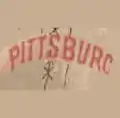 1888: "Alleghenys" Logo
1888: "Alleghenys" Logo 1900–1906
1900–1906 1907
1907 1908–1909
1908–1909 1915–1919
1915–1919 1921, 1932
1921, 1932 1922
1922 1923–1931
1923–1931 1933–1935
1933–1935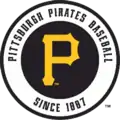 2010–present: Alternate Logo
2010–present: Alternate Logo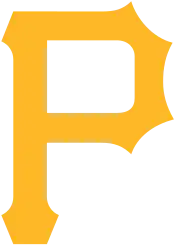 2013–present
2013–present
The Pirates have had many uniforms and logo changes over the years, with the only consistency being the "P" on the team's cap. It was adopted in 1948. Aside from style changes in the cap itself, the "P" logo has remained since.
The Pirates have long been innovators in baseball uniforms. In 1948, the team broke away from the patriotic "Red, White, & Blue" color scheme when they adopted the current black & gold color scheme, to match that of the colors of the Flag of Pittsburgh and, to a lesser extent at the time, the colors of the then-relatively unknown Pittsburgh Steelers of the NFL. While they were not the first baseball team to do this, they were one of the first to do this permanently. Along with the San Francisco Giants, the Pirates are one of two pre-expansion National League teams that completely changed their colors, although red returned as an "accent color" in 1997 and remained until 2009.
In the late 1950s, the team adopted sleeveless jerseys. While not an innovation by the team (the honor goes to the Cincinnati Reds), the Pirates helped popularize the look. The team brought back the vested jerseys in 2001 retaining the style until 2009, although the away jerseys said "Pittsburgh" in script instead of "Pirates." In 2009, they introduced a new home, away and alternate black jersey all with sleeves. However they kept the pinstriped sleeveless vest for Sunday home games.
Coinciding with the move into Three Rivers Stadium in 1970, the team introduced pullover nylon/cotton jerseys and beltless pants as part of their new uniform set (later to become polyester doubleknit), becoming the first team in baseball to sport such a look. This look would quickly be adopted by most teams by the end of the decade and become the prominent look of baseball 1970s and 1980s baseball. The Pirates ditched the pullover style in favor of the traditional button-down style in 1991, one of the last teams to switch.
The Pirates were also innovators in wearing third jerseys. Even though the Oakland A's would wear the jerseys first, the Pirates by 1977 had uniform styles which included two different caps, two different undershirts, three different jerseys and three different pairs of trousers. They actually rotated (and sometimes mixed with painful results) these styles daily until returning to the basic white and gray uniform ensemble in 1985.
In 1976, the National League celebrated its 100th anniversary. To coincide with it, certain NL teams wore old-style pillbox hats complete with horizontal pinstripes. After the season, the Pirates were the only team to adopt the hats permanently, (alternating between a black hat and a gold hat for several seasons until keeping the black hat in 1985) and kept the hat through the 1986 season, which would be Barry Bonds rookie season with the team. The hats, which recall the team's last World Series championship season (1979), remain popular items in the throwback market.
The 2013 season marked the last of one of the team's former logos, introduced in 1997 just after former owner Kevin McClatchy took over the team. The Pirates chose to use the "P" on their caps as the primary logo; however, the former logo will continue to be used as a secondary logo.[66]
On December 13, 2014, the Pirates unveiled a new camo alternate jersey, which honors the soldiers in the Armed Forces. It was worn on every Thursday home game during the 2015 season.[67] The camouflage alternates were replaced by new military appreciation uniforms in the 2018 season, white with camo green wordmarks, numbers, piping, and patches. The bandana on the Pirate sleeve logo was recolored with a camouflage pattern to match.[68]
On February 18, 2016, the Pirates unveiled a new throwback alternate uniform in the style of the 1979 team. This uniform features yellow jerseys and old-style pillbox hats. It was worn on every Sunday home game during the 2016 season.[69]
Ahead of the 2020 season, the Pirates revived script wordmarks on their gray road and new black alternate road jerseys, unveiled on January 24, 2020. Script wordmarks had previously been seen on the road jerseys from 1990 until 2000. The alternate road jersey also features a Pirate wearing a re-colored bandana, yellow to match the theme of the jersey, and is worn with a black cap featuring the "P" logo outlined in black and yellow. The new jersey's addition resulted in the removal of the 1979 throwbacks from the regular rotation.[70]
See also
References
- General
- Markusen, Bruce. The Team That Changed Baseball: Roberto Clemente and the 1971 Pittsburgh Pirates.[71] Yardley: Westholme Publishing. 2005. ISBN 1-59416-030-9
- McCollister, John (1998). The Bucs!: The Story of the Pittsburgh Pirates. Lenexa: Addax Publishing Group. ISBN 1-886110-40-9.
- Nemec, David (2004). The Beer and Whisky League : The Illustrated History of the American Association—Baseball's Renegade Major League. Guilford: The Lyons Press. ISBN 1-59228-188-5.
- In-line citations
- "Pirates Uniforms and Logos". Pirates.com. MLB Advanced Media. Retrieved June 22, 2019.
1948: The team replaced the traditional blue and red with the present day black and gold.
- Berry, Adam (January 8, 2021). "Why Pittsburgh's teams wear black and gold". Pirates.com. MLB Advanced Media. Retrieved January 11, 2021.
- Castrovince, Anthony (May 17, 2019). "Players poll: Who has MLB's best uniforms?". MLB.com. MLB Advanced Media. Retrieved June 22, 2019.
The Steel City’s steadiness in team tints is something to be celebrated. Be it on the ice at PPG Paints Arena, on the gridiron at Heinz Field or within the picture-perfect confines of PNC Park, Pittsburgh is bathed in black and gold. And because even the most garish styles tend to go and come around again, the bumblebee yellow jerseys, striped black pants and pillbox-style hats of the 1970s made a recent return as the go-to Sunday throwbacks.
- "Pittsburgh Pirates end 20-year losing streak", ESPN, September 4, 2013. http://en.espn.co.uk/espn/sport/story/235115.html Retrieved September 28, 2018.
- https://www.baseball-reference.com/postseason/
- "Pittsburgh Pirates Team History & Encyclopedia". Baseball-Reference.com. Retrieved 2020-11-11.
- Britcher, Craig (Spring 2014). "We are Now Pirates: The 1890 Burghers and Alleghenys". Western Pennsylvania History. 97 (1): 42.
- "A Professional Ball Club". The Daily Post. Pittsburgh. October 17, 1881. p. 4 – via Newspapers.com.

- "Charter of Incorporation of Allegheny Base Ball Club of Pgh. Penna." 11 March 1882. Pennsylvania Department of State, Business Entity Search, entity number 6131816. Retrieved 28 March 2018.

- Benswanger, William E. (March–June 1947). "Professional Baseball in Pittsburgh". Western Pennsylvania Historical Magazine. 30 (1–2).
- Why is our baseball team called the Pirates? Pittsburgh City Paper, August 14, 2003.
- "Pirates official team history, part 1". Pittsburgh.pirates.mlb.com. Retrieved December 5, 2010.
- Purdy, Dennis (2006). The Team-by-Team Encyclopedia of Major League Baseball. New York City: Workman. ISBN 0-7611-3943-5.
- "From down 3-1, Cubs working on more history". MLB.com. October 29, 2016. Retrieved September 4, 2020.
- "On this day in 1971, the Pittsburgh Pirates fielded the first all-black and Latino lineup". The Undefeated.com. September 1, 2016. Retrieved September 4, 2020.
- "MLB Teams and Baseball Encyclopedia". Baseball-Reference.com. Archived from the original on July 4, 2013.CS1 maint: unfit URL (link)
- Wilmoth, Charlie (April 6, 2015). "Johnny Cueto, Todd Frazier help Reds beat Pirates 5–2 on Opening Day". Bucs Dugout. Retrieved June 10, 2015.
- "MLB Teams and Baseball Encyclopedia". Baseball-Reference.com. Archived from the original on March 31, 2015.CS1 maint: unfit URL (link)
- Woolsey, Matt (April 28, 2009). "In Depth: Baseball's Most Intense Rivalries". Forbes.
- Collier, Gene (July 4, 2005). "Pirates—Phillies: A Rivalry Lost and Missed". Pittsburgh Post-Gazette. p. D1.
- Von Benko, George (July 7, 2005). "Notes: Phils–Pirates rivalry fading". Philadelphia Phillies. MLB. Retrieved January 3, 2011.
- Stark, Jayson (September 10, 1993). "Baseball Owners Vote to Break Each League Into Three Divisions". Philadelphia Inquirer. p. A1.
- Collier, Gene (September 27, 1993). "Pirates, Phillies Have Owned the Outgoing NL East Division". Pittsburgh Post-Gazette. p. D1.
- "Pirates perform rare three-peat feat 4–2". USA Today. September 28, 1992. p. 5C.
- "It's Philly vs. the Burgh". Pittsburgh Post-Gazette. May 11, 2008. p. B1.
- "The 10 most common postseason matchups". MLB.com. 8 October 2019. Retrieved 3 September 2020.
- "Reds-Pirates brawl results in 40 games of bans". ESPN.com. 1 August 2019. Retrieved 3 September 2020.
- "Carlos Gomez, Travis Snider Ejected as Benches Clear During Brewers vs. Pirates". Bleacher Report. 20 April 2014. Retrieved 3 September 2020.
- "Head-to-Head results for Cleveland Indians vs. Pittsburgh Pirates from 1901 to 2016". Baseball-Reference.com. Sports Reference. 2016. Retrieved May 20, 2016.
- "World Series 1–3 Comebacks – MLB". ESPN. October 27, 2008. Retrieved December 5, 2010.
- MLB.com (January 2, 2010). "LCS, World Series 3–1 comebacks | MLB.com: News". Mlb.mlb.com. Retrieved December 5, 2010.
- "Oakland A's Fan Coalition – Athletics baseball enthusiasts dedicated to watching a winner". Oaklandfans.com. July 12, 1980. Retrieved December 5, 2010.
- "MLB approves protective cap for pitchers in time for 2014 season". Retrieved 2014-04-26.
- "San Diego Padres reliever Alex Torres was the first pitcher to try out MLB's new protective hat". San Diego Padres.
- "Dressed to the Nines: A History of the Baseball Uniform". National Baseball Hall of Fame and Museum. Retrieved November 26, 2014.
- John Perrotto (August 14, 2006). "Baseball Plog". Beaver County Times.
- "Honoring First All-Minority Lineup". New York Times. September 17, 2006. p. Sports p. 2.
- "Sporting News description and assertion of first combined extra-innings no hitter]; [http://www.baseball-reference.com/boxes/PIT/PIT199707120.shtml Box score via Baseball Reference". Archived from the original on 2006-06-23. External link in
|title=(help) - Jenifer Langosch (January 2, 2010). "Indian hurlers' inking opens new market | pirates.com: News". Pittsburgh.pirates.mlb.com. Retrieved December 5, 2010.
- "Pirates find 2 pitchers from Indian reality show – Baseball- NBC Sports". Nbcsports.msnbc.com. November 25, 2008. Archived from the original on July 1, 2010. Retrieved December 5, 2010.
- Jenifer Langosch (January 2, 2010). "Bucs sign pair of Indian hurlers | pirates.com: News". Pittsburgh.pirates.mlb.com. Retrieved December 5, 2010.
- Bruni, Frank (2012-02-22). "Coming Out in the World of Sports". The New York Times. Retrieved 2012-09-22.
- Ex-Pittsburgh Pirates owner Kevin McClatchy comes out as gay – ESPN. Espn.go.com (2012-09-26). Retrieved on 2013-07-23.
- Abrotsky, Justin L.; Stone, Avery (May 9, 2015). "Pittsburgh Pirates pull off first 4–5–4 triple play in MLB history against Cardinals". USA Today. Retrieved May 11, 2015.
- Nesbitt, Stephen J. (April 27, 2017). "Dovydas Neverauskas makes history for Lithuania; Adam Frazier to DL". Pittsburgh Post-Gazette. Retrieved May 5, 2017.
- Pirates' Gift Ngoepe: Promoted by Pirates CBS Sports, 26 April 2017
- Biertempfel, Bob (August 23, 2017). "History at PNC Park! Pirates' Josh Harrison ends Rich Hill's no-hit bid with walk-off homer". Pittsburgh Tribune-Review. Retrieved August 24, 2017.
- "Pittsburgh Pirates Minor League Affiliates". Baseball-Reference. Sports Reference. Retrieved May 13, 2020.
- Negro League Baseball: The Rise and Ruin of a Black Institution – Neil Lanctot – Google Books. Books.google.com. Retrieved on 2013-07-23.
- Let us not forget about Gene Baker. Thesouthern.com (2013-02-19). Retrieved on 2013-07-23.
- Vascellaro, Charlie (September 1, 2011). "Bucs broke ground with first all-minority lineup". Major League Baseball Advanced Media. Retrieved May 18, 2016.
- "Pittsburgh PA News, Weather and Sports - WTAE-TV Pittsburgh Action News 4". WTAE. Archived from the original on 2011-10-05.
- Anderson, Shelly (November 7, 2007). "Penguins Notebook: In this case, No. 20 ranking is huge". Pittsburgh Post-Gazette. Retrieved June 7, 2008.
- America's Game: The Super Bowl Champions. The 1979 Pittsburgh Steelers
- Cook, Ron (September 29, 2000). "The Eighties: A terrible time of trial and error". Pittsburgh Post-Gazette.
- "Pirates Fans Hopeful At Home Opener". 7 April 2011.
- http://www.espn.com/mlb/attendance
- "Annual African American Heritage Weekend Friday, August 20 and Saturday, August 21 to be Hosted by Pitsburg Pirates". Ask Blackie: African American Entertainment, Music, News and Anything Afro-American. Ask Blackie. Archived from the original on April 25, 2012. Retrieved November 3, 2011.
[People] all nominated by their fellow citizens for having positively contributed to the betterment of the diverse community in our region.
- "Piratefest webpage".
- "Pirates Radio Network | pirates.com: Schedule". Pittsburgh.pirates.mlb.com. January 2, 2010. Retrieved December 5, 2010.
- "Smizik on Sports – Pittsburgh Post-Gazette". Communityvoices.sites.post-gazette.com. Retrieved 2013-10-02.
- "Pirates, KDKA-FM agree to broadcasting deal". Pittsburgh.pirates.mlb.com. October 12, 2011. Retrieved October 12, 2011.
- "Pirates, KDKA-FM agree to new contract". Post-Gazette.com. March 2, 2016. Retrieved March 2, 2016.
- Here Are The 2016 MLB Prime Time Television Ratings For Each Team - Maury Brown, Forbes SportsMoney, 28 September 2016
- "Pirates broadcaster leaves for Boston". Post-Gazette.com. December 28, 2015. Retrieved March 3, 2016.
- "Pirates ditch Jolly Roger logo". ESPN. Associated Press. January 8, 2014. Retrieved December 24, 2015.
- "Pittsburgh Pirates Unveil New Camouflage Uniform". Sportslogos.net. SportsLogos.net. December 13, 2014. Retrieved August 31, 2020.
- "Pittsburgh Pirates Introduce New Camo Uniform for 2018". Sportslogos.net. SportsLogos.net. January 13, 2018. Retrieved August 31, 2020.
- "Pirates announce a new Sunday alternate uniform". MLB.com (Press release). MLB Advanced Media. February 18, 2016. Retrieved June 22, 2019.
- "Pirates "Rewrite the Script", Unveil New Road, Alternate Uniforms". Sportslogos.net. SportsLogos.net. January 24, 2020. Retrieved August 31, 2020.
- "The Team That Changed Baseball: Roberto Clemente and the 1971 Pittsburgh Pirates". Westholme Publishing. April 3, 2006. Archived from the original on July 18, 2011. Retrieved December 5, 2010.
External links
| Wikimedia Commons has media related to Pittsburgh Pirates. |
| Preceded by Chicago Cubs 1907 and 1908 Washington Senators 1924 Los Angeles Dodgers 1959 Baltimore Orioles 1970 New York Yankees 1977 and 1978 |
World Series champions Pittsburgh Pirates 1909 1925 1960 1971 1979 |
Succeeded by Philadelphia Athletics 1910 and 1911 St. Louis Cardinals 1926 New York Yankees 1961 and 1962 Oakland Athletics 1972, 1973 and 1974 Philadelphia Phillies 1980 |
| Preceded by Brooklyn Superbas 1900 Chicago Cubs 1906, 1907, 1908 New York Giants 1921, 1922, 1923, and 1924 St. Louis Cardinals 1926 Los Angeles Dodgers 1959 Cincinnati Reds 1970 Los Angeles Dodgers 1978 |
National League champions Pittsburgh Pirates 1901, 1902, and 1903 1909 1925 1927 1960 1971 1979 |
Succeeded by New York Giants 1904, 1905 Chicago Cubs 1910 St. Louis Cardinals 1926 St. Louis Cardinals 1928 Cincinnati Reds 1961 Cincinnati Reds 1972 Philadelphia Phillies 1980 |
| Preceded by New York Mets 1969 New York Mets 1973 Philadelphia Phillies 1976, 1977, and 1978 Chicago Cubs 1989 |
National League Eastern Division champions Pittsburgh Pirates 1970, 1971, and 1972 1974 and 1975 1979 1990, 1991, and 1992 |
Succeeded by New York Mets 1973 Philadelphia Phillies 1976, 1977, and 1978 Philadelphia Phillies 1980 Philadelphia Phillies 1993 |
